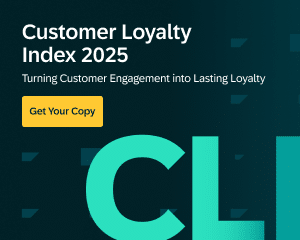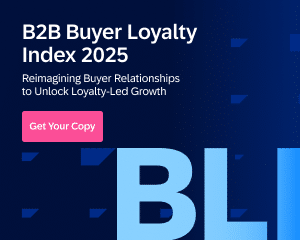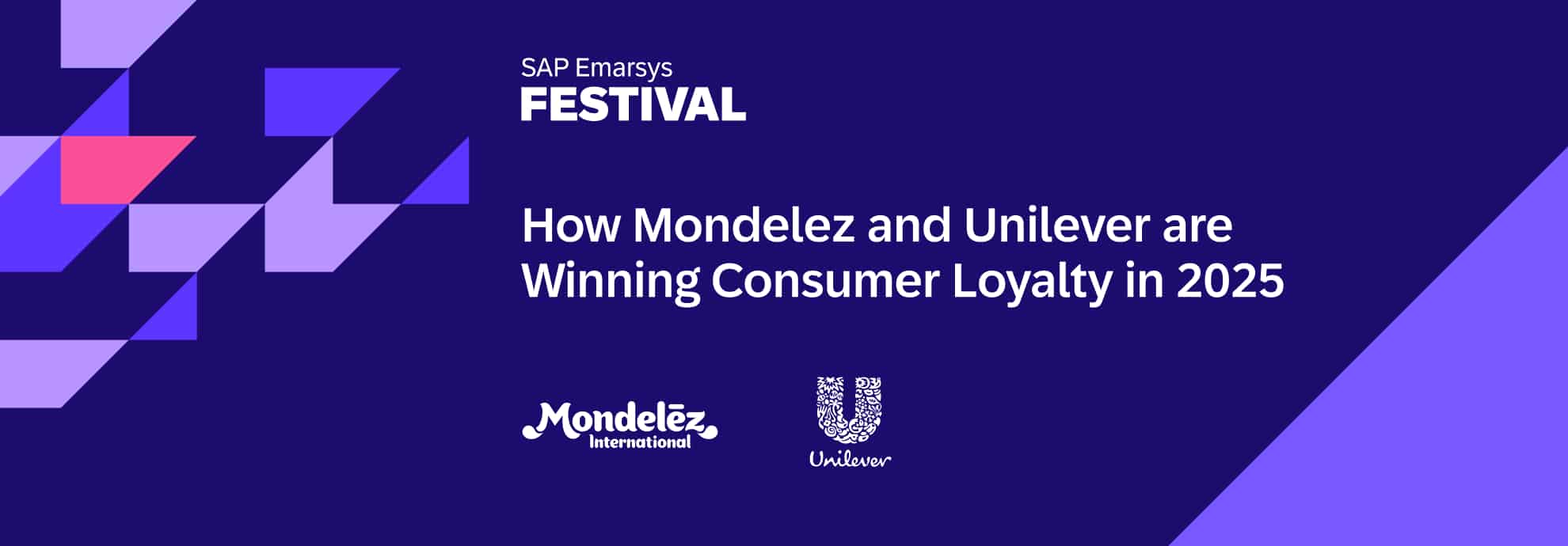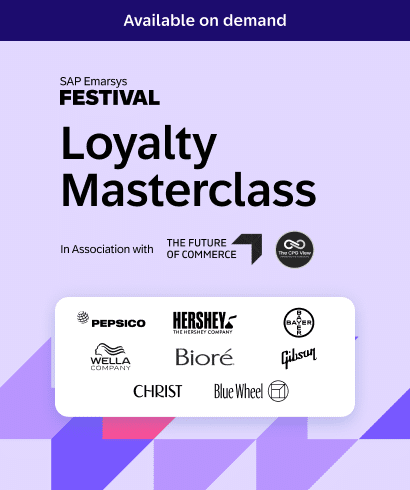With each passing year, the bar for consumer engagement steadily gets higher and higher. Shoppers are moving between digital, in-store, and social without missing a beat, and they expect brands to keep up. That’s forcing marketing teams to rethink how they operate, how they collect and use data, and how they build loyalty in a retail-first world.
In this post, we unpack the key takeaways from a panel discussion with consumer products industry experts, Cristina Marinucci (Mondelez International) and Melda Hamarat (Unilever), at the SAP Emarsys Festival Personalization Masterclass. The conversation covered everything from breaking down internal silos to scaling personalization, working with limited data access, and applying AI in ways that actually make a difference.
If you’re facing the same challenges – siloed teams, fragmented data, and rising expectations – this is how two global Consumer Products leaders are responding. And what you can take from it.
Takeaway 1: Breaking Down Silos Between Shopper, Digital, and Retail Teams
Shopper marketing. Retail media. Digital-first campaigns. Once separate playbooks, now one high-stakes game. Today’s consumers don’t see channels, they see your brand. And they expect it to show up the same way whether they’re in-store, on social, or tapping through their favorite retailer’s app.
That’s why leading brands like Mondelez and Unilever are breaking down internal silos and rebuilding for the real world: connected, always-on, and omnichannel by default.
Integration is only the starting point. What matters is the impact it creates.
When every team, channel, and message is aligned, brands can stop reacting and start leading. And in a world where every second counts, that’s the edge you need to win both hearts and market share.
“For years these were treated as separate silos. Your traditional shopper marketing was focused on those in-store activations, while digital-first strategies really emphasized the online engagement. So now, consumers are expecting that consistent seamless experience, regardless of how they interact.”
What this means for you: If your teams are still operating in isolation, you’re likely creating fragmented experiences for consumers. Start by aligning teams around shared KPIs, and unify your view of the consumer journey across all channels.
Takeaway 2: Leveraging first-party data for personalized engagement
First-party data is what makes personalized marketing actually work – especially when you don’t control the full consumer journey. But for brands that don’t rely heavily on DTC, building a robust first-party data strategy can feel like trying to run before learning to walk.
That’s where leaders like Mondelez and Unilever are getting creative.
From partnerships with retailers to loyalty programs and contextual data capture, they’re finding new ways to collect and activate valuable consumer insights – even without owning the full path to purchase.
For brands to turn insight into action, the key isn’t collecting more data – it’s collecting the right data, being transparent with consumers, and using that trust to deliver real value in return.
What this means for you: Even if you don’t own the checkout, you can still build a strong data strategy. Look to partnerships, contextual engagement, and value-led incentives to start building a usable first-party dataset.
Takeaway 3: Treat consumer engagement like a personal relationship
If consumers are going to hand over their personal data, they expect something meaningful in return – not just a discount code, but relevance, convenience, and recognition. That exchange is the foundation of trust. And once trust is earned, it has to be nurtured.
One-off interactions won’t cut it. Your brand needs a plan for how that relationship deepens over time.
At Johnson & Johnson, Cristina Marinucci helped develop a progressive profiling approach that collected consumer insights over time, building the relationship gradually rather than overwhelming people with questions upfront. The key was timing and relevance — asking for the right information in the right moment, and following through with clear value.
“We did progressive profiling... We don't ask everything upfront. No consumer wants to go through a lengthy intake and give you all the information about them and their household... You want to start with basic information and gradually gather more over time, especially as you build that trust. Make it relevant, make it contextual, and show the benefit immediately — not months later.”
Collecting data is only part of the job — how you use it to build relationships is what matters. Brands that approach it with the same care and respect they’d show in any meaningful relationship are the ones most likely to earn loyalty that lasts.
What this means for you: Don’t front-load data collection — earn it gradually. Build trust through timely, relevant interactions, and give consumers a clear reason to keep engaging with your brand.
Takeaway 4: Optimizing omnichannel engagement to drive loyalty
With more engagement channels than ever, from email and mobile to retail media and social, brand consistency has never mattered more. Each interaction shapes how consumers perceive your brand. If those signals aren’t aligned, trust erodes fast.
Melda Hamarat, Global Head of Digital Commerce Strategy at Unilever, made it clear — branding only works if it holds up across every channel.
Whether it’s a TV ad, a TikTok ad, or a product page thumbnail, the experience should be unmistakably yours.
She also highlighted the ROPO effect, research online, purchase offline, as proof that digital engagement drives real-world results. When messaging is clear and the journey is smooth, online interest turns into in-store action.
What this means for you: Consistency is your competitive edge. Define your brand’s key assets and ensure they show up clearly across every channel — from packaging and TV to TikTok and retail media.
Takeaway 5: Staying competitive in retailer-driven ecosystems
Most consumer brands still depend on retail partnerships to reach consumers — but the trade-off is clear: limited control over placements, visibility, and data. In a space dominated by retail media networks, maintaining brand equity while playing by someone else’s rules requires careful balance.
Cristina Marinucci (Mondelez) explained how brands can stay competitive by strengthening their own channels — not in opposition to retailers, but in parallel. Direct consumer relationships, brand.com experiences, and strong social media presence all help create distinct value beyond the retailer shelf.
Melda Hamarat added that creators and influencers are now critical in bridging this gap, and acting as a direct line to consumers with messaging that feels more authentic than brand ads alone.
Together, these strategies give brands more control over how they’re perceived and more freedom to build lasting connections, even when the transaction itself happens elsewhere.
What this means for you: Relying on retail media is smart, but risky. Invest in your own channels, build experiences that deepen loyalty, and find creative ways to co-own the consumer journey with your retail partners.
Takeaway 6: The growing role of AI in consumer engagement
AI holds huge potential for marketers — but getting started can feel overwhelming. Cristina Marinucci’s advice? “Don’t try to boil the ocean.”
Instead, focus on solving one real problem at a time.
At Mondelez, the team is using AI to tackle specific challenges through small, focused pilots — the kind that produce quick wins, build momentum, and make the case for broader investment.
Cristina also called out high-impact opportunities across insights generation, trend analysis, concept testing, demand forecasting, inventory optimization, and digital shelf management. The real value of AI comes from freeing up teams to do what matters most.
What this means for you: Start small, stay focused, and measure impact. Look for repeatable tasks AI can take off your team’s plate, then reinvest that time into higher-impact work like creative strategy or consumer analysis.
Conclusion
The future of consumer engagement is now. Brands that once operated in silos are now uniting shopper marketing, retail media, and digital strategies into a single, connected engine for growth.
What sets leaders like Mondelez and Unilever apart is their commitment to understanding the consumer, investing in first-party data, and building the operational backbone to deliver relevance at scale. From aligning teams to activating insights to piloting AI, everything they do points back to one goal: deeper, more durable consumer relationships.
Closing that gap requires action. Start with the data you have. Break down the barriers between channels and teams. Test, learn, and scale. And most importantly — build with your consumer at the center, every step of the way.
Want the full picture?
Watch the SAP Emarsys Personalization Masterclass to hear directly from Christina Marinucci, Melda Hamarat and other industry leaders as they share actionable insights on personalization, loyalty and consumer engagement in 2025 and beyond.







